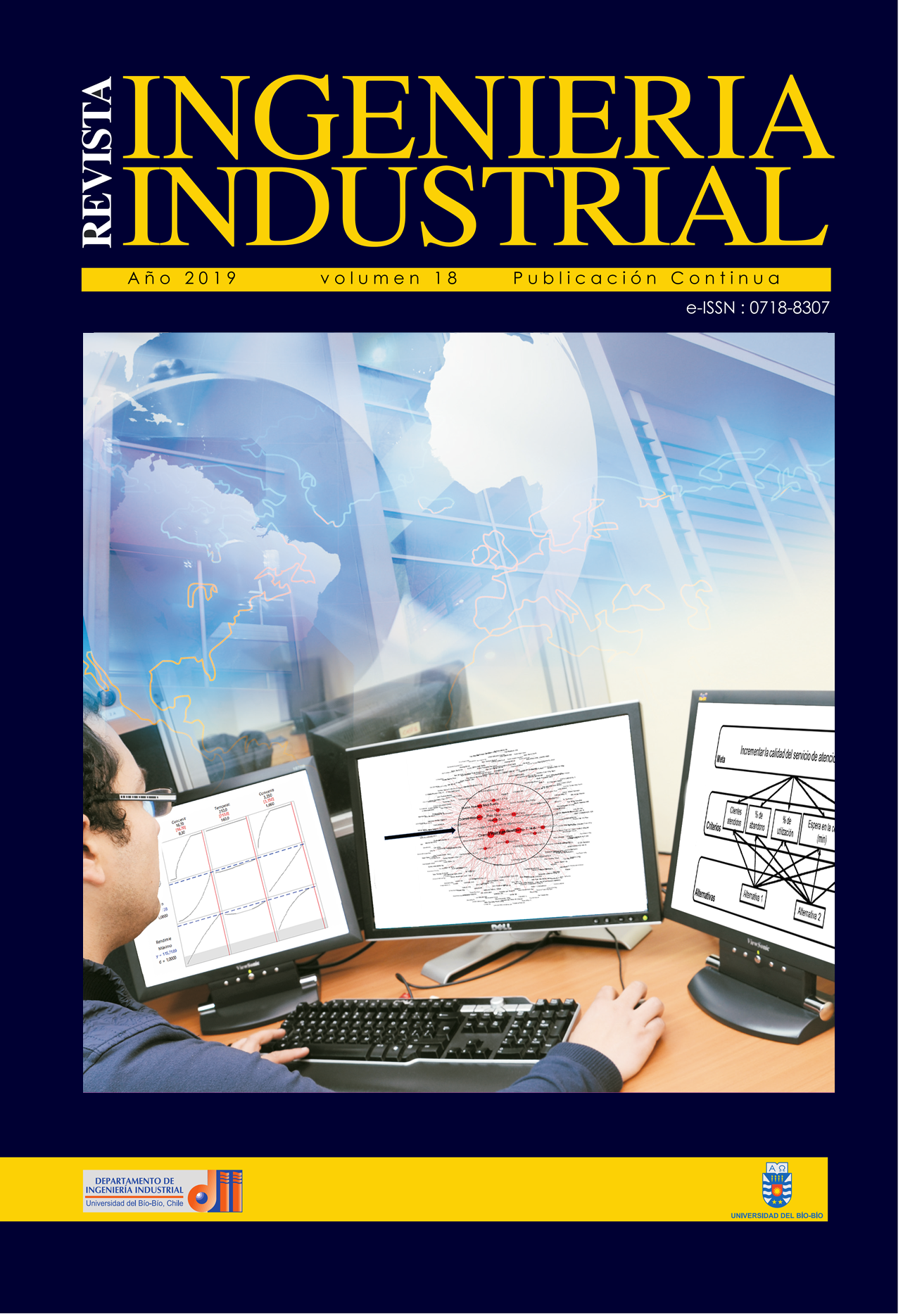ANÁLISIS DE LOS COMPROBANTES DE COMPRA DE UN MINORISTA APLICANDO REDES COMPLEJAS
DOI:
https://doi.org/10.22320/S07179103/2019.05Palabras clave:
Comprobantes de compra, relaciones entre productos, centralidad, redes complejasResumen
Las empresas, tiendas y negocios generan grandes cantidades de comprobantes de pago y con frecuencia son la única fuente de información sobre la forma en que se relacionan y agrupan los productos. Se analizaron los comprobantes de compra de una tienda minorista aplicando el enfoque de redes complejas. El catálogo consta de 272 productos pero los artículos se relacionan en promedio con 10 productos. A partir de la modularidad, se identificaron 39 familias de artículos; se muestran 2 ejemplos de ofertas de artículos para adquirirse juntos. Las compras forman una red tipo “mundo-pequeño” ordenada alrededor de tres productos relevantes. Esta red ha alcanzado un estado donde la probabilidad de que un artículo establezca una nueva conexión es baja. Los resultados se compararon con el sistema de clasificación ABC del inventario, los resultados muestran una clasificación que complementa el análisis y gestión de un inventario.
Descargas
Citas
AKTAS, E., y MENG, Y. (2017). An Exploration of Big Data Practices in Retail Sector. Logistics [en línea], 1(2), 1-28. Disponible: https://doi:10.3390/logistics1020012
AMARAL, L.A., SCALA, A., BARTHELEYMY, M. STANLEY, E. (2000). Classes of smallworld networks. Proceedings of National Academy of Sciences of USA, 97(21), 11149-11152. Disponible: https://doi:10.1073/pnas.200327197
BARÁBASI, A. Complex Networks. 152 – 153. Cambridge: Cambridge University Press. 2016 BARTHELEMY, M. (2011). Spatial Networks. Physics Reports [en línea], 499(1-3), 1-101. Disponible: https://doi:10.1016/j.physrep.2010.11.002
BASTIAN, M., HEYMANN, S. JACOMY, M. (2009). Gephi: an open source software for exploring and manipulating networks. En: Proceedings Third international AAAI conference on weblogs and social media [en línea]. pp.361-362. 2009. Disponible en: https://www.aaai. org/ocs/index.php/ICWSM/09/paper/view/154/1009
BLONDEL, V., GUILLAUME, J.L., LAMBIOTTE, R., y LEFEBVRE, E. (2008) Fast unfolding of communities in large networks. Journal of Statistic Mechanics: Theory and Experiments [en línea], 1-12. Disponible: https://doi:10.1088/1742-5468/2008/10/P10008
CEBALLOS – CARDONA, Y., ROBLEDO – GIRALDO, S. y DUQUE – MÉNDEZ, N. (2016). Network marketing en microempresas. Incidencia de la estrategia de referidos utilizando redes complejas y modelado basado en agentes. Revista Vínculos [en línea], 13(1), 6-16. Disponible en: https://revistas.udistrital.edu.co/index.php/vinculos/article/view/11659/12790
CONSEJO NACIONAL de EVALUACIÓN de la POLÍTICA de DESARROLLO SOCIAL. CONEVAL. Evolución del valor de la canasta alimentaria. 2018. [En línea]. Disponible en: https://www.coneval.org.mx/Medicion/MP/Paginas/Lineas-de-bienestar-y-canasta-basica. aspx
DI CLEMENTE, R., LUNEGO-OROZ, M., TRAVIZANO, M., Xu, S., VAITLA, B. y GONZÁLEZ, M. (2018). Sequences of purchases in credit card data reveal lifestyles in urban populations. Nature Communications [en línea], 1-8. Disponible: https://doi:10.1038/s41467-018-05690-8
ESTRADA, A. Análisis de sistemas de servicios aplicando métricas del análisis de redes sociales para el diagnóstico y una mejor toma de decisiones. Tesis de Maestría. HERNÁNDEZ – GONZÁLEZ, Salvador (dir.) Celaya: Tecnológico Nacional de México en Celaya. 2018.
FREEMAN, L. (1977). A set of measures of centrality based on betweenness. Sociometry [en línea], ISSN 2325-7938, 40(1), 35-41. Disponible: https://doi:10.2307/3033543
HASHEMIAN, B., MASSARO, E., BOJIC, I., MURILLO – ARIAS, J., SOBOLEVSKY, S. y RATTI, C. (2017). Socioeconomic characterization of regions through the lens of individual financial transactions. PLOS One [en línea], 12(11), 1-20. Disponible: https://doi:10.1371/ journal.pone.0187031
HEARNSHAW, E. y WILSON, M. (2013). A complex network approach to supply chain network theory. International Journal of Operations & Production Management [en línea], 33(4), 442469. Disponible: https://doi:10.1108/01443571311307343
HUANG, Z., ZENG, D. y CHEN, H. (2007). Analyzing consumer-product graphs: Empirical findings and applications in recommender systems. Management Science [en línea], 53(7), 1146-1154. Disponible: https://doi:10.1287/mnsc.1060.0619
KIM, H., KIM, J., y CHEN, Q. (2012). A product network analysis for extending the market basket analysis. Expert Systems and Applications [en línea], 39(8), ISSN 7403-7410. Disponible: https://doi:10.1016/j.eswa.2012.01.066
NAVARRO, O., FERRER, W. y BURGOSO D. (2018). La calidad como factor estratégico en el desarrollo competitivo de las Pequeñas y medianas empresas. Universidad y Sociedad [en línea], 10(2), 171-174. Disponible en: http://scielo.sld.cu/scielo.php?script=sci_ arttext&pid=S2218-36202018000200171
NEWMAN, M. E. (2003). The structure and function of complex networks. SIAM Review [en línea], 45(2), 167-256. Disponible: https://doi:10.1137/S003614450342480
PENNACCHIOLI, D., COSCIA, M., RINZIVILLO, S., GIANOTTI, F. y PEDRESCI, D. (2014). The retail market as a complex system. EPJ Data Science [en línea], 3(33), 1-27. Disponible: https://doi:10.1140/epjds/s13688-014-0033-x
RAEDER, T. y CHAWLA, N. Modeling a store’s product space as a social network. En: Proceedings of International Conference on Advances in Social Network Analysis and Mining [en línea]. Athens: Greece, 2009. Disponible: https://doi:10.1109/ASONAM.2009.53
RODRÍGUEZ, F., FLORES, L. y DÁVILA, E. (2016) Inteligencia de negocios y minería de datos aplicado a la industria refresquera. Research in Computing revista Science [en línea], 126, 63–71. Disponible en: https://pdfs.semanticscholar.org/ed31/ f60175e0b6d3efd82789b1778cfbb363c369.pdf
Sha, Z., Huang, Y., Sophia Fu, J., Wang, M., Fu, Yan., Contractor, N. y Chen, W. (2018). A network-based approach to modeling and predicting product coconsideration relations. Complexity [en línea], 2018, 1-13. Disponible: https://doi:10.1155/2018/2753638
VALLE, M., RUZ, G. y MORRÁS, R. (2018). Market basket analysis: Complementing association rules with minimum spanning trees. Expert Systems and Applications [en línea], 97(1), 146-162. Disponible: https://doi:10.1016/j.eswa.2017.12.028
VIDELA, I., y RÍOS, S. (2014). Extending market basket analysis with graph mining. Expert Systems and Applications [en línea], 41(4), 1928-1936. Disponible: https://doi:10.1016/j. eswa.2013.08.088
WAN, M., CHEN, W., FU, Y. y YANG, Y. (2015) Analyzing and Predicting Heterogeneous Customer Preferences in China’s AutoMarket Using Choice Modeling and Network Analysis. SAE International Journal of Materials Manufacturing [en línea], 8(3), 1-10. Disponible: https:// doi:10.4271/2015-01-0468
WANG, X. y CHEN, G. (2003) Complex networks: small world, scale-free and beyond. IEEE circuits and systems magazine [en línea], 3(1), 6-20. Disponible: https://doi: 10.1109/ MCAS.2003.1228503
ZHAO, T., McAULEY, J., LI, M. y KING, I. Improving Recommendation Accuracy using Networks of subtitutable and complementary products. En. International Joint Conference on Neural Networks [en línea]. Anchorage: AK, 2017. Disponible: https://doi:10.1109/ IJCNN.2017.7966315
ZUO, Y., YADA, K., LI, T. y PHILIP, C. Application of Network Analysis Techniques for Customer In-store Behavior in Supermarket. En: Proceedings IEEE International Conference on Systems, Man, and Cybernetics [en línea]. Miyazaki: Japan, 2018. ISBN 978-1-53866650-0. Disponible: https://doi:10.1109/SMC.2018.00322
Descargas
Publicado
Número
Sección
Licencia

Esta obra está bajo una licencia internacional Creative Commons Atribución 4.0.
Revista Ingeniería Industrial by Revista Ingeniería Industrial is licensed under a Creative Commons Reconocimiento 4.0 Internacional License. Creado a partir de la obra en revistas.ubiobio.cl/index.php/RI/. Puede hallar permisos más allá de los concedidos con esta licencia en http://revistas.ubiobio.cl/index.php/RI/about/

















